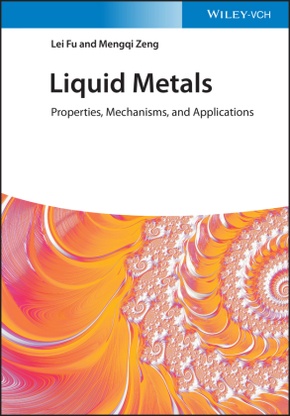
Liquid Metals - Properties, Mechanisms and Applications
| Verlag | Wiley-VCH |
| Auflage | 2022 |
| Seiten | 432 |
| Format | 17,6 x 2,3 x 25,2 cm |
| Gewicht | 968 g |
| Artikeltyp | Englisches Buch |
| ISBN-10 | 3527828184 |
| EAN | 9783527828180 |
| Bestell-Nr | 52782818A |
This book begins by providing the readers with a thorough understanding of liquid metals with a focus on their structure and physicochemical properties, preparation methods and tuning strategies. Subsequently, it illustrates the details of the applications of liquid metals in the fields such as mediated synthesis, 3D printer, flexible electronics, biomedicine, and energy storage and conversion.
Inhaltsverzeichnis:
PART I FUNDAMENTALS OF LIQUID METAL
1 INTRODUCTION
1.1 The discovery and development history of liquid metal
1.2 Liquid metal family
1.3 Overview of liquid metal
2 STRUCTURE AND PHYSICAL PROPERTIES OF LIQUID METAL
2.1 Structure of liquid metal
2.2 Low melting point of liquid metal
2.3 Rheological properties of liquid metal
2.4 Electrical conductivity of liquid metal
2.5 Thermal property of liquid metal
2.6 Surface properties of liquid metal
2.7 Liquid metal in other dimensions
2.8 Conclusion
3 PREPARATION OF LIQUID METAL
3.1 Introduction
3.2 Preparation of liquid metal droplets
3.3 Preparation of liquid metal nanowires
3.4 Preparation of liquid metal nanosheets
3.5 Conclusion and prospect
4 EXTERNAL FIELD TUNING OF LIQUID METAL
4.1 Introduction
4.2 Electrical field tuning
4.3 Magnetic field tuning
4.4 Chemical tuning
4.5 Force field tuning
4.6 Others
4.7 Conclusion and prospect PART II EMERGENT APPLICATIONS OF LIQUID METAL
5 LIQUID METAL AS A NEW REACTION MEDIUM
5.1 Introduction
5.2 Nanomaterial synthesis
5.3 Alloy preparation
5.4 Conclusion and prospect
6 CONSTRUCTING TECHNIQUES OF LIQUID METAL-BASED ARCHITECTURES
6.1 Introduction
6.2 Injecting
6.3 Imprinting
6.4 Mask-assisted depositing
6.5 Direct writing
6.6 Laser ablating
6.7 External field guiding
6.8 Others
6.9 Conclusion and prospect
7 LIQUID METAL TOWARD FLEXIBLE ELECTRONICS
7.1 Introduction
7.2 Traditional materials for flexible electronics
7.3 Advantages of liquid metals
7.4 Construction strategies for liquid-metal-based flexible electronics
7.5 Typical flexible electronics based on liquid metals
7.6 Summary and outlook
8 LIQUID METAL FOR BIOMEDICINE
8.1 Introduction
8.2 Therapeutics
8.3 Biomedical imaging
8.4 Biomimetics
8.5 Biodevices
8.6 Conclusion and prospect
9 LIQUID METAL FO R ENERGY
9.1 Introduction
9.2 Liquid metal as electrodes
9.3 Liquid metal as coolants
9.4 Liquid metal as catalysis
9.5 Conclusion and prospect
